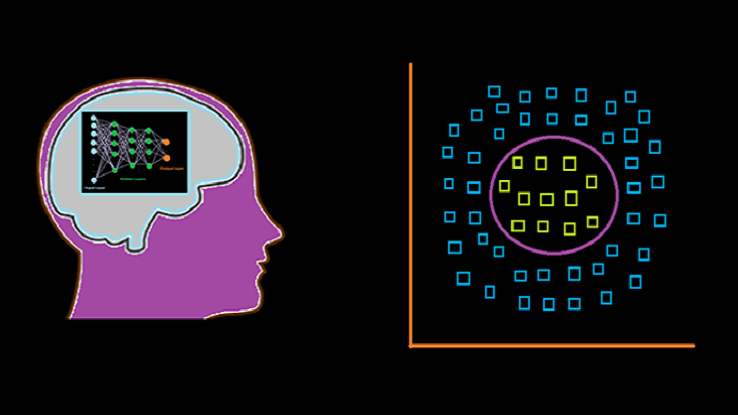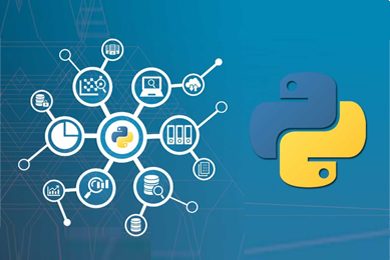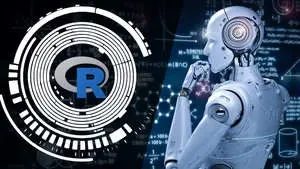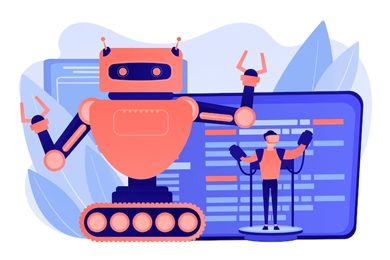This plan includes
- Limited free courses access
- Play & Pause Course Videos
- Video Recorded Lectures
- Learn on Mobile/PC/Tablet
- Quizzes and Real Projects
- Lifetime Course Certificate
- Email & Chat Support
What you'll learn?
- Theory, Maths and Implementation of machine learning and deep learning algorithms.
- Regression Analysis
- Classification Models used in classical Machine Learning such as Logistic Regression, KNN, Support Vector Machines, Decision Trees, Random Forest, and Boosting Methods in Machine Learning.
- Build Artificial Neural Networks and use them for Regression and Classification Problems.
- Using GPU with Deep Learning Models.
- Convolutional Neural Networks
- Transfer Learning
- Recurrent Neural Networks
- Time series forecasting and classification
- Autoencoders
- Generative Adversarial Networks (GANs)
- Python from scratch
- Numpy, Matplotlib, Seaborn, Pandas, PyTorch, Scikit-learn and other Python libraries.
Course Overview
Introduction
Introduction of the Course
Introduction to Machine Learning and Deep Learning
Introduction to Google Colab
Python Crash Course
Data Preprocessing
Supervised Machine Learning
Regression Analysis
Logistic Regression
K-Nearest Neighbor (KNN)
Bayes Theorem and Naive Bayes Classifier
Support Vector Machine (SVM)
Decision Trees
Random Forest
Boosting Methods in Machine Learning
Introduction to Neural Networks and Deep Learning
Activation Functions
Loss Functions
Back Propagation
Neural Networks for Regression Analysis
Neural Networks for Classification
Dropout Regularization and Batch Normalization
Convolutional Neural Network (CNN)
Recurrent Neural Network (RNN)
Generative Adversarial Network (GAN)
Autoencoders
Unsupervised Machine Learning
K-Means Clustering
Hierarchical Clustering
Density Based Spatial Clustering Of Applications With Noise (DBSCAN)
Gaussian Mixture Model (GMM) Clustering
Principal Component Analysis (PCA)
Pre-requisites
- Gmail Account ( For Google Colab )
Target Audience
- Students in Machine Learning and Deep Learning course.
- Beginners Who want to Learn Machine Learning and Deep Learning from Scratch.
- Researchers in Artificial Intelligence
- Students and Researchers who want to develop Python Programming skills to solve Machine Learning and Deep Learning Tasks.
Curriculum 306 Lectures 20:58:10
Section 1 : Introduction of the course
- Lecture 2 :
- Course Material
Section 2 : Introduction to Machine Learning and Deep Learning
- Lecture 1 :
- Introduction of the Section
- Lecture 2 :
- What is Intelligence ?
- Lecture 3 :
- Machine Learning
- Lecture 4 :
- Supervised Machine Learning
- Lecture 5 :
- Unsupervised Machine Learning
- Lecture 6 :
- Deep Learning
Section 3 : Introduction to Google Colab
- Lecture 1 :
- Introduction of the Section
- Lecture 2 :
- Importing Dataset in Google Colab
- Lecture 3 :
- Importing and Displaying Image in Google Colab
- Lecture 4 :
- Importing More Datasets
- Lecture 5 :
- Uploading Course Material on Your Google Drive
Section 4 : Python Crash Course
- Lecture 1 :
- Introduction of the Section
- Lecture 2 :
- Arithmetic With Python
- Lecture 3 :
- Comparison and Logical Operations
- Lecture 4 :
- Conditional Statements
- Lecture 5 :
- Dealing With Arrays Part-01
- Lecture 6 :
- Dealing With Arrays Part-02
- Lecture 7 :
- Dealing With Arrays Part-03
- Lecture 8 :
- Plotting and Visualization Part-01
- Lecture 9 :
- Plotting and Visualization Part-02
- Lecture 10 :
- Plotting and Visualization Part-03
- Lecture 11 :
- Plotting and Visualization Part-04
- Lecture 12 :
- Lists In Python
- Lecture 13 :
- For Loops Part-01
- Lecture 14 :
- For Loops Part-02
- Lecture 15 :
- Strings in Python
- Lecture 16 :
- Print formatting With Strings
- Lecture 17 :
- Dictionaries Part-01
- Lecture 18 :
- Dictionaries Part-02
- Lecture 19 :
- Functions in Python Part-01
- Lecture 20 :
- Functions in Python Part-02
- Lecture 21 :
- Pandas Part-01
- Lecture 22 :
- Pandas Part-02
- Lecture 23 :
- Pandas Part-03
- Lecture 24 :
- Pandas Part-04
- Lecture 25 :
- Seaborn Part-01
- Lecture 26 :
- Seaborn Part-02
- Lecture 27 :
- Seaborn Part-03
- Lecture 28 :
- Tuples
- Lecture 29 :
- Classes in Python
Section 5 : Data Preprocessing
- Lecture 1 :
- Introduction of the Section
- Lecture 2 :
- Need Of Data Preprocessing
- Lecture 3 :
- Data Normalization and Min-Max Scaling
- Lecture 4 :
- Project01-Data Normalization and Min-Max Scaling Part-01
- Lecture 5 :
- Project01-Data Normalization and Min-Max Scaling Part-02
- Lecture 6 :
- Data Standardization
- Lecture 7 :
- Project02-Data Standardization
- Lecture 8 :
- Project03-Dealing With Missing Values
- Lecture 9 :
- Project04-Dealing With Categorical Features
- Lecture 10 :
- Project05-Feature Engineering
- Lecture 11 :
- Project06-Feature Engineering by Window Method
Section 6 : Supervised Machine Learning
- Lecture 1 :
- Supervised Machine Learning
Section 7 : Regression Analysis
- Lecture 1 :
- Introduction of the Section
- Lecture 2 :
- Origin of the Regression
- Lecture 3 :
- Definition of Regression
- Lecture 4 :
- Requirements from Regression
- Lecture 5 :
- Simple Linear Regression
- Lecture 6 :
- Multiple Linear Regression
- Lecture 7 :
- Target and Predicted Values
- Lecture 8 :
- Loss Function
- Lecture 9 :
- Regression With Least Square Method
- Lecture 10 :
- Least Square Method With Numerical Example
- Lecture 11 :
- Evaluation Metrics For Regression
- Lecture 12 :
- Project01-Simple Regression-Part01
- Lecture 13 :
- Project01-Simple Regression-Part02
- Lecture 14 :
- Project01-Simple Regression-Part03
- Lecture 15 :
- Project02-Multiple Regression-Part01
- Lecture 16 :
- Project02-Multiple Regression-Part02
- Lecture 17 :
- Project02-Multiple Regression-Part03
- Lecture 18 :
- Project03-Another Multiple Regression
- Lecture 19 :
- Regression By Gradient Descent
- Lecture 20 :
- Project04-Simple Regression With Gradient Descent
- Lecture 21 :
- Project05-Multiple Regression With Gradient Descent
- Lecture 22 :
- Polynomial Regression
- Lecture 23 :
- Project06-Polynomial Regression
- Lecture 24 :
- Cross-validation
- Lecture 25 :
- Project07-Cross-validation
- Lecture 26 :
- Underfitting and Overfitting (Bias-Variance Trade off)
- Lecture 27 :
- Concept of Regularization
- Lecture 28 :
- Ridge OR L2- Regularization
- Lecture 29 :
- Lasso Regression OR L1-Regularization
- Lecture 30 :
- Comparing Ridge and Lasso Regression
- Lecture 31 :
- Elastic Net Regularization
- Lecture 32 :
- Project08-Regularizations
- Lecture 33 :
- Grid Search Cross-validation
- Lecture 34 :
- Project09-Grid Search Cross-validation
Section 8 : Logistic Regression
- Lecture 1 :
- Introduction of the Section
- Lecture 2 :
- Fundamentals of Logistic Regression
- Lecture 3 :
- Limitations of Regression Models
- Lecture 4 :
- Transforming Linear Regression Into Logistic Regression
- Lecture 5 :
- Project01-Getting Class Probabilities-Part01
- Lecture 6 :
- Project01-Getting Class Probabilities-Part02
- Lecture 7 :
- Loss Function
- Lecture 8 :
- Model Evaluation-Confusion Matrix
- Lecture 9 :
- Accuracy, Precision, Recall and F1-Score
- Lecture 10 :
- ROC Curves and Area Under ROC
- Lecture 11 :
- Project02-Evaluating Logistic Regression Model
- Lecture 12 :
- Project03-Cross-validation With Logistic Regression Model
- Lecture 13 :
- Project04-Multiclass Classification
- Lecture 14 :
- Project05-Classification With Challenging Dataset-Part01
- Lecture 15 :
- Project05-Classification With Challenging Dataset-Part02
- Lecture 16 :
- Project05-Classification With Challenging Dataset-Part03
- Lecture 17 :
- Grid Search Cross-validation With Logistic Regression
Section 9 : K-Nearest Neighbors (KNN)
- Lecture 1 :
- Introduction of the Section
- Lecture 2 :
- Intuition Behind KNN
- Lecture 3 :
- Steps of KNN Algorithm
- Lecture 4 :
- Numerical Example of KNN Algorithm
- Lecture 5 :
- Project01-KNN Algorithm-Part01
- Lecture 6 :
- Project01-KNN Algorithm-Part02
- Lecture 7 :
- Finding Optimal Value of K
- Lecture 8 :
- Project02-Implementing KNN
- Lecture 9 :
- Project03-Implementing KNN
- Lecture 10 :
- Project04-Implementing KNN
- Lecture 11 :
- Advantages and Disadvantages of KNN
Section 10 : Bayes Theorem and Naive Bayes Classifier
- Lecture 1 :
- Introduction of the Section
- Lecture 2 :
- Fundamentals of Probability
- Lecture 3 :
- Conditional Probability and Bayes Theorem
- Lecture 4 :
- Numerical Example on Bayes Theorem
- Lecture 5 :
- Naive Bayes Classification
- Lecture 6 :
- Comparing Naive Bayes Classification With Logistic Regression
- Lecture 7 :
- Project01-Naive Bayes as Probabilistic Classifier
- Lecture 8 :
- . Project02_Comparing Naive Bayes and Logistic Regression
- Lecture 9 :
- Project03_Multiclass Classification With Naive Bayes Classifier
Section 11 : Support Vector Machines (SVM)
- Lecture 1 :
- Introduction of the Section
- Lecture 2 :
- Basic Concept of SVM
- Lecture 3 :
- Maths of SVM
- Lecture 4 :
- Hard and Soft Margin Classifier
- Lecture 5 :
- Decision Rules of SVM
- Lecture 6 :
- Kernel Trick in SVM
- Lecture 7 :
- Project01-Understanding SVM-Part01
- Lecture 8 :
- Project01-Understanding SVM-Part02
- Lecture 9 :
- Project02-Multiclass Classification With SVM
- Lecture 10 :
- Project03-GridSearch CV-Part01
- Lecture 11 :
- Project03-GridSearch CV-Part02
- Lecture 12 :
- Project04-Breast Cancer Classification
Section 12 : Decision Tree
- Lecture 1 :
- Introduction of the Section
- Lecture 2 :
- Concept of Decision Tree
- Lecture 3 :
- Important Terms Related to Decision Tree
- Lecture 4 :
- Entropy-An information Gain Criterion
- Lecture 5 :
- Numerical Example on Entropy-Part01
- Lecture 6 :
- Numerical Example on Entropy-Part02
- Lecture 7 :
- Gini Impurity-An Information Criterion
- Lecture 8 :
- Numerical Example on Gini Impurity
- Lecture 9 :
- Project01- Decision Tree Implementation
- Lecture 10 :
- Project02- Decision Tree Implementation
- Lecture 11 :
- Project03- Grid Search CV With Decision Tree
Section 13 : Random Forest
- Lecture 1 :
- Introduction of the Section
- Lecture 2 :
- Why Random Forest
- Lecture 3 :
- Working of Random Forest
- Lecture 4 :
- Hyper Parameters of Random Forest
- Lecture 5 :
- Boot Strap Sampling and OOB Error
- Lecture 6 :
- Project01-Random Forest-Part01
- Lecture 7 :
- Project01-Random Forest-Part02
- Lecture 8 :
- Project02-Random Forest-Part01
- Lecture 9 :
- Project02-Random Forest-Part02
Section 14 : Boosting Methods in Machine Learning
- Lecture 1 :
- Introduction of the Section
- Lecture 2 :
- Adaboost ( Adaptive Boosting )
- Lecture 3 :
- Numerical Example on AdaBoost
- Lecture 4 :
- Project01-Adaboost Classifier
- Lecture 5 :
- Project02-Adaboost Classifier
- Lecture 6 :
- Gradient Boosting
- Lecture 7 :
- Numerical Example on Gradient Boosting
- Lecture 8 :
- Project03-Gradient Boosting
- Lecture 9 :
- Project03-Gradient Boosting
- Lecture 10 :
- Extreme Gradient Boosting (XG Boost)
- Lecture 11 :
- Project05-XGBoost-Part01
- Lecture 12 :
- Project05-XGBoost-Part02
Section 15 : Unsupervised Machine Learning
- Lecture 1 :
- Unsupervised Machine Learning
Section 16 : K-Means Clustering
- Lecture 1 :
- Introduction of the Section
- Lecture 2 :
- Steps of K-means Clustering
- Lecture 3 :
- Numerical Example-K-means clustering in one D
- Lecture 4 :
- Numerical Example-K-means clustering in 2D
- Lecture 5 :
- Objective Function
- Lecture 6 :
- Selecting Optimal Number of Clusters (Elbow Method)
- Lecture 7 :
- Evaluating Metric for K-means clustering
- Lecture 8 :
- Project01-K means clustering-Part01
- Lecture 9 :
- Project01-K means clustering-Part02
- Lecture 10 :
- Project01-K means clustering-Part03
- Lecture 11 :
- Project02-K means clustering
- Lecture 12 :
- Project03-K means clustering
Section 17 : Hierarchical Clustering
- Lecture 1 :
- Introduction of the Section
- Lecture 2 :
- Hierarchical Clustering Algorithm
- Lecture 3 :
- Hierarchical Clustering Algorithm in One D
- Lecture 4 :
- Dendrograms-Selecting Optimal Clusters-Part01
- Lecture 5 :
- Dendrograms-Selecting Optimal Clusters-Part02
- Lecture 6 :
- Hierarchical Clustering Using d-max criterion
- Lecture 7 :
- Hierarchical Clustering in 2D
- Lecture 8 :
- Evaluating Metric for Hierarchical Clustering
- Lecture 9 :
- Project01-Hierarchical Clustering-Part01
- Lecture 10 :
- Project01-Hierarchical Clustering-Part02
- Lecture 11 :
- Project02-Hierarchical Clustering
- Lecture 12 :
- Project03-Hierarchical Clustering
Section 18 : Density Based Spatial Clustering of Applications With Noise (DBSCAN)
- Lecture 1 :
- Introduction of the Section
- Lecture 2 :
- Definition of DBSCAN
- Lecture 3 :
- Step by Step DBSCAN
- Lecture 4 :
- Comparing DBSCAN With K-means clustering
- Lecture 5 :
- Project01-DBSCAN-Part01
- Lecture 6 :
- Project01-DBSCAN-Part02
- Lecture 7 :
- Parameters of DBSCAN
- Lecture 8 :
- Project02-DBSCAN
Section 19 : Gaussian Mixture Model ( GMM ) Clustering
- Lecture 1 :
- Introduction of the Section
- Lecture 2 :
- Definition of GMM Clustering
- Lecture 3 :
- Limitations of K-means Clustering
- Lecture 4 :
- Project01-GMM Clustering
- Lecture 5 :
- Project02-GMM Clustering
- Lecture 6 :
- Project03-GMM Clustering
- Lecture 7 :
- Binomial Distribution
- Lecture 8 :
- Expectation Maximization (EM) Algorithm
- Lecture 9 :
- Expectation Maximization (EM) Algorithm (Numerical Example)
Section 20 : Principal Component Analysis (PCA)
- Lecture 1 :
- Introduction of the Section
- Lecture 2 :
- Key Concepts of PCA
- Lecture 3 :
- Need of PCA
- Lecture 4 :
- Numerical Example on PCA
- Lecture 5 :
- Project01-PCA
- Lecture 6 :
- Project02-PCA
- Lecture 7 :
- Project03-PCA
- Lecture 8 :
- Project04-PCA
- Lecture 9 :
- Project05-PCA
- Lecture 10 :
- Project06-PCA
Section 21 : Deep Learning
- Lecture 1 :
- Deep Learning
Section 22 : Introduction to Neural Networks and Deep Learning
- Lecture 1 :
- Introduction of the section
- Lecture 2 :
- The Perceptron
- Lecture 3 :
- Features, Weight and Activation Function
- Lecture 4 :
- Learning of Neural Network
- Lecture 5 :
- Rise of Deep Learning
Section 23 : Activation Functions
- Lecture 1 :
- Introduction of the Section
- Lecture 2 :
- Classification by Perceptron-Part01
- Lecture 3 :
- Classification by Perceptron-Part02
- Lecture 4 :
- Need of Activation Functions
- Lecture 5 :
- Adding Activation Functions to Neural Network
- Lecture 6 :
- Sigmoid as Activation Function
- Lecture 7 :
- Hyperbolic Tangent Function
- Lecture 8 :
- ReLU and Leaky ReLU Function
Section 24 : Loss Functions
- Lecture 1 :
- Introduction of the Section
- Lecture 2 :
- MSE Loss Function
- Lecture 3 :
- Cross Entropy Loss Function
- Lecture 4 :
- Softmax Function
Section 25 : Back Propagation
- Lecture 1 :
- Introduction of the Section
- Lecture 2 :
- Forward Propagation
- Lecture 3 :
- Backward Propagation-Part01
- Lecture 4 :
- Backward Propagation-Part02
Section 26 : Neural Networks for Regression Analysis
- Lecture 1 :
- Introduction of the Section
- Lecture 2 :
- Project01-Neural Network for Simple Regression-Part01
- Lecture 3 :
- Project01-Neural Network for Simple Regression-Part02
- Lecture 4 :
- Project02-Neural Network for Multiple Regression
- Lecture 5 :
- Creating Neural Network Using Python Class
Section 27 : Neural Network for Classification
- Lecture 1 :
- Introduction of the Section
- Lecture 2 :
- Epoch, Batch size and Iteration
- Lecture 3 :
- Project00-Tensor Dataset and Data Loader
- Lecture 4 :
- Code Preparation for Iris Dataset
- Lecture 5 :
- Project01-Neural Network for Iris Data Classification
- Lecture 6 :
- Code Preparation for MNIST dataset
- Lecture 7 :
- Project02-Neural Network for MNIST data classification-Part01
- Lecture 8 :
- Project02-Neural Network for MNIST data classification-Part02
- Lecture 9 :
- Save and Load Trained Model
- Lecture 10 :
- Code Preparation for Custom Images
- Lecture 11 :
- Project03- Neural Network for Custom Images
- Lecture 12 :
- Code Preparation for Human Action Recognition
- Lecture 13 :
- Project04-Neural Network for Human Action Recognition
- Lecture 14 :
- Project05- Neural Network for Feature Engineered Dataset
Section 28 : Dropout Regularization and Batch Normalization
- Lecture 1 :
- Introduction of the Section
- Lecture 2 :
- Dropout Regularization
- Lecture 3 :
- Introducing Dataset for dropout Regularization
- Lecture 4 :
- Project01-Dropout Regularization
- Lecture 5 :
- Project02-Dropout Regularization
- Lecture 6 :
- Batch Normalization
- Lecture 7 :
- Project03-Batch Normalization
- Lecture 8 :
- Project03-Batch Normalization
Section 29 : Convolutional Neural Network (CNN)
- Lecture 1 :
- Introduction of the Section
- Lecture 2 :
- CNN Architecture and main operations
- Lecture 3 :
- 2D Convolution
- Lecture 4 :
- Shape of Feature Map After Convolution
- Lecture 5 :
- Average and Maximum Pooling
- Lecture 6 :
- Pooling to Classification
- Lecture 7 :
- Project01-CNN on MNIST-Part01
- Lecture 8 :
- Project01-CNN on MNIST-Part01
- Lecture 9 :
- An Efficient Lazy Linear Layer
- Lecture 10 :
- Project02-CNN on Custom Images
- Lecture 11 :
- Transfer Learning
- Lecture 12 :
- Project03-Transfer Learning With ResNet
- Lecture 13 :
- Project03-Transfer Learning With VGG-16
Section 30 : Recurrent Neural Network (RNN)
- Lecture 1 :
- Introduction of the Section
- Lecture 2 :
- Why we need RNN
- Lecture 3 :
- Sequential data
- Lecture 4 :
- ANN to RNN
- Lecture 5 :
- Back Propagation Through Time
- Lecture 6 :
- Long-Short term Memory ( LSTM )
- Lecture 7 :
- LSTM Gates
- Lecture 8 :
- Project01-LSTM Shapes
- Lecture 9 :
- Project01-LSTM Basics
- Lecture 10 :
- Batch Size, Sequence Length and Feature Dimension
- Lecture 11 :
- Project03-Interpolation and Extrapolation With LSTM
- Lecture 12 :
- Project04-Data Classification With LSTM
Section 31 : Autoencoders
- Lecture 1 :
- Introduction of the Section
- Lecture 2 :
- Architecture of Autoencoder
- Lecture 3 :
- Application of Autoencoder
- Lecture 4 :
- Project01-Image Denoising Using Autoencoder
- Lecture 5 :
- Project02-Occlusion Removing Using Autoencoder
- Lecture 6 :
- Project03-Autoencoder as an Image Classifier
Section 32 : Generative Adversarial Networks ( GANs )
- Lecture 1 :
- Introduction of the Section
- Lecture 2 :
- Discriminative and Generative Models
- Lecture 3 :
- Training of GAN
- Lecture 4 :
- Project01_GAN Implementation
Our learners work at
Frequently Asked Questions
How do i access the course after purchase?
It's simple. When you sign up, you'll immediately have unlimited viewing of thousands of expert courses, paths to guide your learning, tools to measure your skills and hands-on resources like exercise files. There’s no limit on what you can learn and you can cancel at any time.Are these video based online self-learning courses?
Yes. All of the courses comes with online video based lectures created by certified instructors. Instructors have crafted these courses with a blend of high quality interactive videos, lectures, quizzes & real world projects to give you an indepth knowledge about the topic.Can i play & pause the course as per my convenience?
Yes absolutely & thats one of the advantage of self-paced courses. You can anytime pause or resume the course & come back & forth from one lecture to another lecture, play the videos mulitple times & so on.How do i contact the instructor for any doubts or questions?
Most of these courses have general questions & answers already covered within the course lectures. However, if you need any further help from the instructor, you can use the inbuilt Chat with Instructor option to send a message to an instructor & they will reply you within 24 hours. You can ask as many questions as you want.Do i need a pc to access the course or can i do it on mobile & tablet as well?
Brilliant question? Isn't it? You can access the courses on any device like PC, Mobile, Tablet & even on a smart tv. For mobile & a tablet you can download the Learnfly android or an iOS app. If mobile app is not available in your country, you can access the course directly by visting our website, its fully mobile friendly.Do i get any certificate for the courses?
Yes. Once you complete any course on our platform along with provided assessments by the instructor, you will be eligble to get certificate of course completion.
For how long can i access my course on the platform?
You require an active subscription to access courses on our platform. If your subscription is active, you can access any course on our platform with no restrictions.Is there any free trial?
Currently, we do not offer any free trial.Can i cancel anytime?
Yes, you can cancel your subscription at any time. Your subscription will auto-renew until you cancel, but why would you want to?
Instructor

4861 Course Views
4 Courses



 Tech & IT
Tech & IT
 Business
Business
 Coding & Developer
Coding & Developer
 Finance & Accounting
Finance & Accounting
 Academics
Academics
 Office Applications
Office Applications
 Art & Design
Art & Design
 Marketing
Marketing
 Health & Wellness
Health & Wellness
 Sounds & Music
Sounds & Music
 Lifestyle
Lifestyle
 Photography
Photography




















